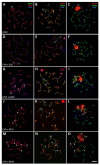Chromosome Asynapsis Is the Main Cause of Male Sterility in the Interspecies Hybrids of East Asian Voles (Alexandromys, Rodentia, Arvicolinae)
- PMID: 37239382
- PMCID: PMC10218298
- DOI: 10.3390/genes14051022
Chromosome Asynapsis Is the Main Cause of Male Sterility in the Interspecies Hybrids of East Asian Voles (Alexandromys, Rodentia, Arvicolinae)
Abstract
Closely related mammalian species often have differences in chromosome number and morphology, but there is still a debate about how these differences relate to reproductive isolation. To study the role of chromosome rearrangements in speciation, we used the gray voles in the Alexandromys genus as a model. These voles have a high level of chromosome polymorphism and substantial karyotypic divergence. We investigated testis histology and meiotic chromosome behavior in the captive-bred colonies of Alexandromys maximowiczii, Alexandromys mujanensis, two chromosome races of Alexandromys evoronensis, and their interracial and interspecies hybrids, to explore the relationship between karyotypic differences and male hybrid sterility. We found that the seminiferous tubules of the males of the parental species and the interracial hybrids, which were simple heterozygotes for one or more chromosome rearrangements, contained germ cells at all stages of spermatogenesis, indicating their potential fertility. Their meiotic cells displayed orderly chromosome synapsis and recombination. In contrast, all interspecies male hybrids, which were complex heterozygotes for a series of chromosome rearrangements, showed signs of complete sterility. Their spermatogenesis was mainly arrested at the zygotene- or pachytene-like stages due to the formation of complex multivalent chains, which caused extended chromosome asynapsis. The asynapsis led to the silencing of unsynapsed chromatin. We suggest that chromosome asynapsis is the main cause of meiotic arrest and male sterility in the interspecies hybrids of East Asian voles.
Keywords: chromosomal polymorphism; crossing over; gray voles; hybrid sterility; synaptonemal complex.
Conflict of interest statement
The authors declare no conflict of interest.
Figures





References
Publication types
MeSH terms
LinkOut - more resources
Full Text Sources
Medical

